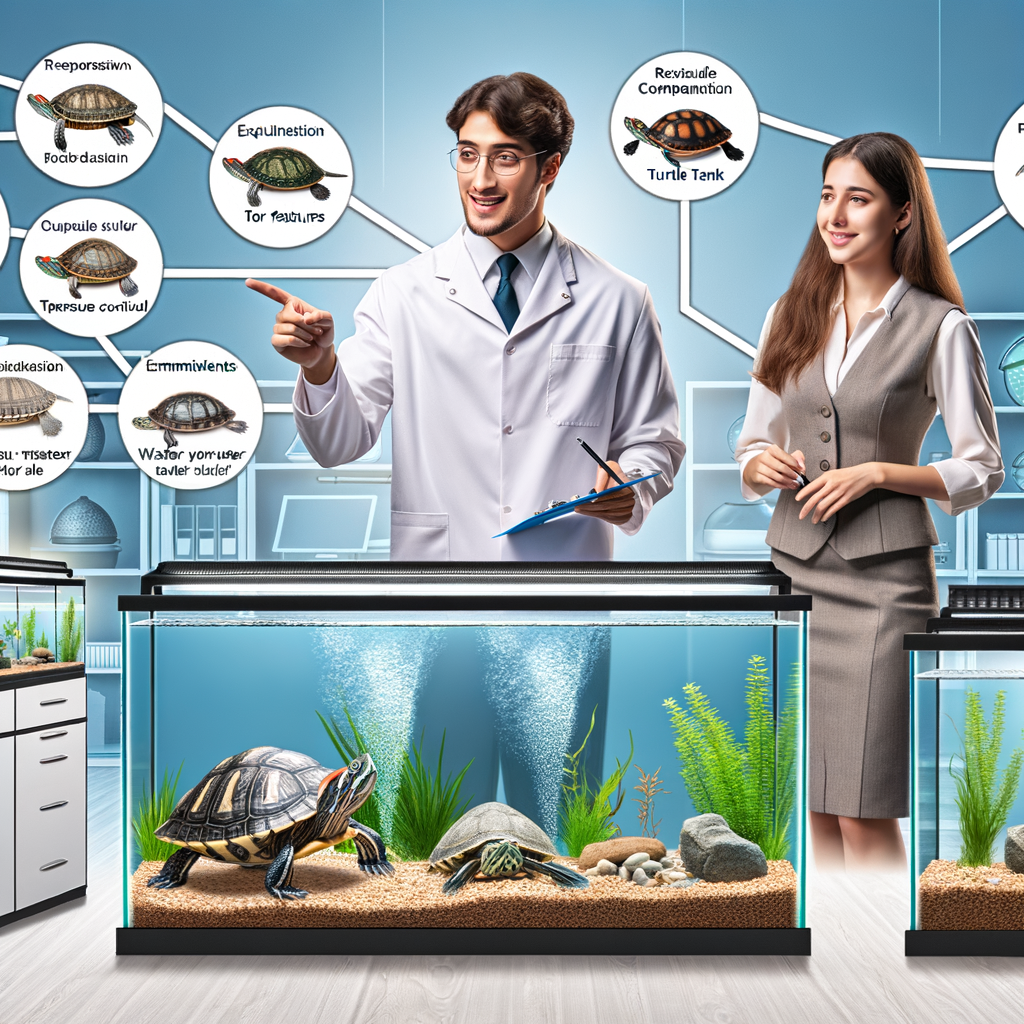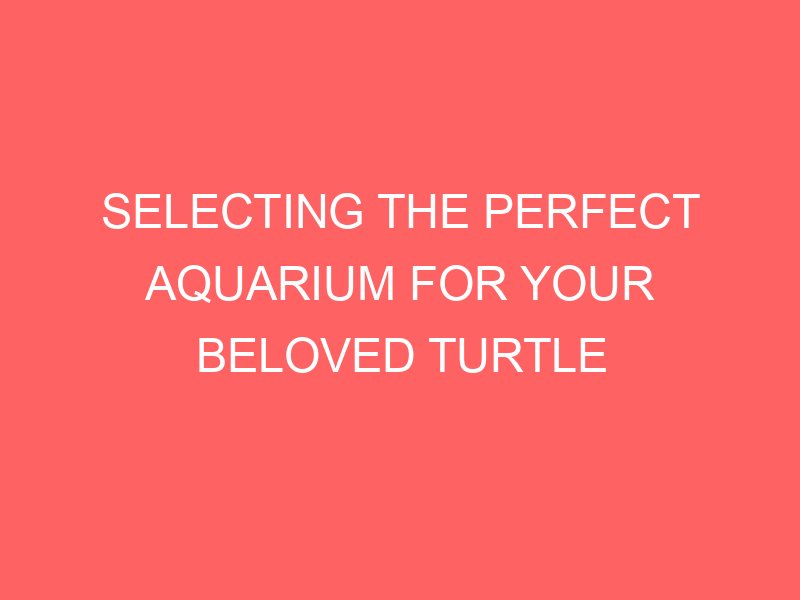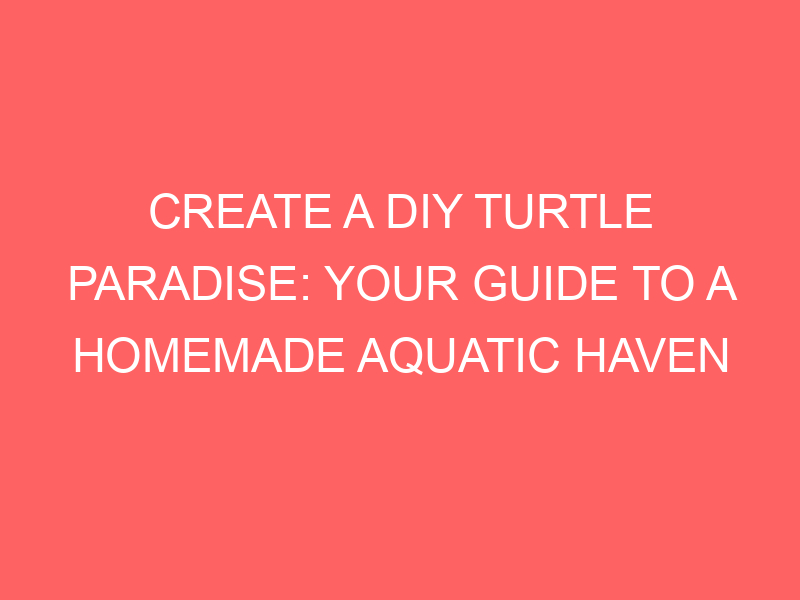
Turtle Aquarium Guide: An Introduction
When it comes to caring for turtles, one of the most important aspects is their living environment. This is where the turtle aquarium comes into play. It’s not just a container for your pet; it’s their home, their playground, and their world. Therefore, it’s crucial to understand the significance of a suitable aquarium for turtles and the key factors to consider when choosing one.
- Understanding the Importance of a Suitable Aquarium for Turtles
The right aquarium can make a world of difference for your turtle’s health and happiness. Turtles are sensitive creatures that require specific conditions to thrive. They need a certain amount of space, clean water, and a place to bask in the sun. An inadequate aquarium can lead to stress, illness, and a shortened lifespan for your turtle.
For example, a study conducted by the University of Veterinary Medicine in Vienna found that turtles living in unsuitable conditions often suffer from health problems such as shell deformities and respiratory diseases. This highlights the importance of providing your turtle with a suitable aquarium.
- Key Factors to Consider When Choosing a Turtle Aquarium
When choosing a turtle aquarium, there are several factors to consider. First, the size of the aquarium is crucial. Turtles need plenty of room to swim and explore. As a general rule, the aquarium should be five times the length of the turtle.
Secondly, the material of the aquarium is also important. Glass is a popular choice because it’s durable and easy to clean. However, plastic can also be a good option if it’s sturdy and resistant to scratches.
Lastly, the design of the aquarium should cater to the turtle’s needs. It should have a dry area for basking, a swimming area, and a hiding spot. The temperature and lighting should also be controlled to mimic the turtle’s natural habitat.
In conclusion, understanding the importance of a suitable aquarium and considering key factors when choosing one can greatly contribute to your turtle’s well-being. Remember, a happy turtle is a healthy turtle!
Choosing Turtle Tanks: Size Matters
When it comes to selecting a home for your pet turtle, size is a crucial factor to consider. The size of the tank directly impacts the health and happiness of your turtle. In this section, we will explore how to determine the right tank size for your turtle and provide examples of suitable tank sizes for different turtle species.
Turtle Aquarium Size: How Big Should It Be?
The size of your turtle’s aquarium should be determined by the size of the turtle itself. A common rule of thumb is that for every inch of your turtle’s shell length, you should provide 10 gallons of tank space. This ensures that your turtle has enough room to swim, bask, and explore.
- Understanding the correlation between turtle size and tank size
- Examples of suitable tank sizes for different turtle species
It’s essential to understand that as your turtle grows, so should its tank. A small tank can lead to health issues such as shell deformities and stress. A larger tank provides more swimming and basking areas, which are crucial for a turtle’s physical and mental well-being. For instance, a turtle with a shell length of 5 inches should have a 50-gallon tank, while a turtle with a shell length of 10 inches needs a 100-gallon tank.
Different turtle species grow to different sizes, and thus require different tank sizes. Here are some examples:
| Turtle Species | Adult Size | Suggested Tank Size |
|---|---|---|
| Red-Eared Slider | 12 inches | 120 gallons |
| Painted Turtle | 10 inches | 100 gallons |
| Musk Turtle | 5 inches | 50 gallons |
Remember, these are just guidelines. Always monitor your turtle’s behavior and adjust the tank size as needed. A happy turtle is an active turtle, so provide as much space as you can!
Best Aquarium for Turtles: Material Considerations
When choosing the best aquarium for your turtle, the material of the tank is an important factor to consider. The two most common materials are glass and plastic. Each has its own set of advantages and disadvantages. Let’s take a closer look.
-
Pros and Cons of Glass Aquariums
Many turtle owners prefer glass aquariums. Here’s why:
- Pro: Glass aquariums are very durable and can last for many years if properly maintained.
- Pro: They offer a clear view of your turtle, making it easier to observe their behavior and ensure they are healthy.
- Pro: Glass doesn’t scratch easily, so your view of your turtle won’t be obstructed over time.
However, glass aquariums also have some downsides:
- Con: They are heavier than plastic aquariums, making them more difficult to move.
- Con: Glass can break if dropped or hit hard, which can lead to a dangerous situation for both you and your turtle.
-
Pros and Cons of Plastic Aquariums
Plastic aquariums are another option for turtle owners. Here are some points to consider:
- Pro: Plastic aquariums are lightweight, making them easier to move and clean.
- Pro: They are generally less expensive than glass aquariums.
- Pro: Plastic is less likely to break if dropped, making it a safer option if you have children or pets.
On the other hand, plastic aquariums also have some disadvantages:
- Con: They can scratch easily, which can obstruct your view of your turtle over time.
- Con: Plastic aquariums may not last as long as glass ones, as they can become brittle and crack over time.
In conclusion, both glass and plastic aquariums have their own sets of pros and cons. Your choice will depend on your specific needs and circumstances. Remember, the most important thing is that your turtle has a safe and comfortable home.
Turtle Companion Care: Sharing the Space
When it comes to turtle care, one of the most important aspects is understanding how to manage the space within the turtle’s habitat. This is especially crucial if you plan to introduce a new turtle to an existing aquarium. Let’s delve into the details.
Choosing Turtle Aquarium: Co-habitation Concerns
Introducing a new turtle to an existing aquarium can be a tricky process. It requires careful planning and consideration to ensure a smooth transition and peaceful co-habitation. Here are a few factors to consider:
- Factors to consider when introducing a new turtle to an existing aquarium
- Case study: Successful turtle co-habitation
Firstly, it’s important to consider the size of your aquarium. If it’s too small, the turtles may feel cramped and stressed, leading to potential health issues. Secondly, consider the temperament of your existing turtle. Some turtles are more territorial than others and may not take kindly to a new roommate. Lastly, consider the species of the turtles. Different species have different needs and may not be compatible with each other.
Let’s look at a real-life example of successful turtle co-habitation. In a study conducted by a renowned turtle expert, two Red-Eared Sliders were introduced into a 100-gallon tank. The tank was divided into separate zones for feeding, basking, and hiding to cater to the turtles’ different needs. Over time, the turtles learned to share the space peacefully, demonstrating that with careful planning and consideration, successful turtle co-habitation is possible.
In conclusion, sharing the space in a turtle aquarium requires careful planning and consideration. By taking into account the size of the aquarium, the temperament of the existing turtle, and the species of the turtles, you can create a peaceful and harmonious environment for your shelled friends.
Aquarium Setup for Turtles: Creating the Ideal Turtle Habitat
Creating the perfect habitat for your turtle is not as simple as filling a tank with water. It requires careful consideration of various factors, including temperature control and the choice of substrate. Let’s delve into these aspects to help you create a comfortable and healthy environment for your turtle.
- Importance of temperature control in a turtle aquarium
Temperature plays a crucial role in a turtle’s health and well-being. Turtles are cold-blooded creatures, meaning their body temperature adjusts to their environment. Therefore, maintaining the right temperature in the aquarium is essential.
Typically, the water temperature should be between 75-85°F (24-29°C), and the basking area should be around 90-95°F (32-35°C). This temperature variation allows the turtle to regulate its body temperature by moving between the warmer and cooler areas of the tank.
Using a high-quality aquarium heater and thermometer will help maintain these temperatures. Remember, too cold or too hot temperatures can lead to health problems, including sluggishness, loss of appetite, and even life-threatening conditions.
- Choosing the right substrate for your turtle tank
The substrate is the material you place at the bottom of the tank. It serves both aesthetic and functional purposes. The right substrate can make your turtle feel at home and help maintain the cleanliness of the tank.
Gravel, sand, and river rocks are common choices for turtle tanks. However, the best substrate for your turtle depends on its species. For instance, aquatic turtles prefer fine gravel or sand, while terrestrial turtles do better with a mixture of soil and sand.
It’s important to avoid small, loose substrates that your turtle could accidentally ingest while feeding. This could lead to impaction, a serious health issue. Also, ensure the substrate is easy to clean, as turtles can be messy eaters.
In conclusion, creating the ideal turtle habitat requires careful consideration of temperature control and substrate choice. By paying attention to these factors, you can ensure your turtle thrives in its new home.
Turtle Tank Recommendations: Top Picks
Choosing the right aquarium for your turtle can be a daunting task. There are many factors to consider, such as the size of your turtle, the material of the tank, and the overall setup. To make your decision easier, we have compiled a list of the top picks for both small and large turtles.
-
Review of the Best Aquariums for Small Turtles
Small turtles require a tank that provides enough space for them to swim, bask, and hide. Here are our top recommendations:
Aquarium Name Size Material Special Features Tetra Deluxe Aquatic Turtle Kit 20 Gallons Glass Basking platform, heat lamp, water filter Zilla Turtle Aquatic Kit 10 Gallons Glass Lockable lid, water heater, basking platform Both of these options are excellent for small turtles. They provide ample space for swimming and basking, and come with additional features that make turtle care easier.
-
Review of the Best Aquariums for Large Turtles
Large turtles require more space than their smaller counterparts. Here are our top picks for large turtle aquariums:
Aquarium Name Size Material Special Features SeaClear Acrylic Aquarium Combo Set 50 Gallons Acrylic Light fixture, clear visibility Marineland Portrait Glass LED Aquarium Kit 40 Gallons Glass LED lighting, curved front glass panel These aquariums are perfect for large turtles. They offer plenty of room for swimming and exploring, and their special features enhance the overall turtle habitat.
Remember, the happiness of your turtle is just a tank away. Choose wisely and create the perfect habitat for your shelled friend.
Turtle Habitat Setup: Maintenance and Cleaning
Keeping your turtle’s habitat clean and well-maintained is crucial for its health and happiness. In this section, we will discuss regular cleaning practices for a healthy turtle aquarium and key takeaways for maintaining an ideal turtle habitat.
- Regular cleaning practices for a healthy turtle aquarium
Regular cleaning of your turtle’s aquarium is essential to prevent the build-up of harmful bacteria and algae. Here are some steps to follow:
- Weekly Partial Water Changes: Every week, remove and replace about 20% of the water in the tank. This helps to keep the water fresh and clean without causing a drastic change in the water chemistry that could stress your turtle.
- Monthly Full Clean: Once a month, empty the tank completely. Clean the tank and decorations with a solution of one part white vinegar to nine parts water. Rinse thoroughly before refilling the tank.
- Filter Maintenance: Clean the filter regularly as per the manufacturer’s instructions. A dirty filter can’t effectively remove waste and toxins from the water.
- Key takeaways: Maintaining an ideal turtle habitat
Here are some key points to remember when maintaining your turtle’s habitat:
- Consistency is Key: Turtles thrive in stable environments. Try to keep the temperature, lighting, and water conditions as consistent as possible.
- Monitor Health: Regularly observe your turtle for any signs of illness. Changes in behavior, appetite, or appearance can be early signs of a problem.
- Provide a Balanced Diet: A balanced diet is crucial for your turtle’s health. Feed a variety of foods, including commercial turtle pellets, leafy greens, and occasional treats of fruits and proteins.
In conclusion, maintaining a clean and stable environment is crucial for your turtle’s health. Regular cleaning, consistent conditions, and a balanced diet can help ensure your turtle thrives.
Conclusion: Your Turtle’s Happiness is Just a Tank Away
As we wrap up this comprehensive guide, it’s important to remember that the happiness and health of your pet turtle largely depends on the environment you create for it. The right aquarium is more than just a tank; it’s your turtle’s home, playground, and sanctuary.
- Recap of the importance of choosing the right aquarium for your turtle
- Final thoughts on creating and maintaining an ideal turtle habitat
Choosing the right aquarium for your turtle is crucial. The size, material, and design of the tank can significantly impact your turtle’s health and happiness. A small or poorly designed tank can lead to stress, illness, and a shortened lifespan for your turtle. On the other hand, a spacious, well-ventilated, and clean tank can provide your turtle with a comfortable and stimulating environment, promoting its well-being and longevity.
Creating and maintaining an ideal turtle habitat involves more than just selecting the right tank. It also includes setting up the tank properly, ensuring it has a balanced mix of land and water areas, providing appropriate heating and lighting, and keeping the tank clean and safe. Regular maintenance and monitoring are key to ensuring your turtle’s habitat remains ideal for its needs. Remember, a happy turtle is an active, curious, and healthy turtle.
In conclusion, your turtle’s happiness truly is just a tank away. By investing time, effort, and thought into choosing and maintaining the right aquarium, you can ensure your turtle enjoys a long, healthy, and happy life. After all, our pets depend on us for their well-being, and as responsible pet owners, it’s our duty to provide them with the best care possible.














